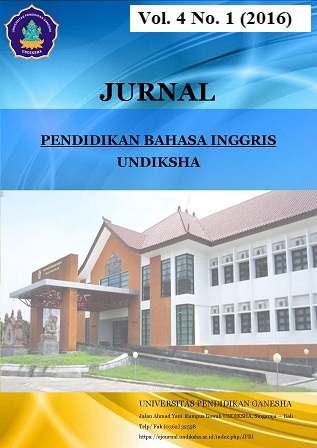Affixation of Balinese Language in Julah Dialect: A Descriptive Study
DOI:
https://doi.org/10.23887/jpbi.v4i1.8080Abstract
Penelitian ini bertujuan untuk mendeskripsikan awalan dan akhiran infleksi dan awalan dan akhiran derivasi dari Dialek Julah di desa Julah. Penelitian ini merupakan penelitian deskriptif kualitatif.Tiga contoh informan dari Dialek Julah dipilih berdasarkan kriteria yang ditentukan. Data dikumpulkan berdasarkan tiga teknik, yaitu: observasi, teknik perekaman, dan teknik wawancara (mendengarkan dan mencatat). Hasil penelitian menunjukkan bahwa ada dua jenis awalan di Dialek Julah yang termasuk derivasi, awalan {mә-}, dan {ŋ-}. Ada sembilan jenis awalan di Dialek Julah yang termasuk infleksi, awalan {mә-}, {n-}, {ŋ-}, {ñ-}, {m-}, {Λ-}, {kΛ}, {pΛ-}, {pә}. Ada tiga jenis akhiran di Dialek Julah yang termasuk derivasi, akhiran {-Λŋ}, {-In}, {Λ-}. Ada dua jenis akhiran di Dialek Julah yang termasuk infleksi, akhiran {-ē}, dan {- nē}. Awalan dan akhiran di Dialek Julah yang termasuk derivasi adalah awalan {mә-} dan{m-}dan akhiran {-Λŋ} dan {-In}. Awalan dan akhiran di Dialek Julah yang temasuk infleksi adalah awalan {n-}, {ŋ-},{-ñ}, {m-}{-Λ}, {-kΛ}, {m-}, {pΛ-} dan {pә-}dan akhiran {ē-}, dan{-nē}. Fungsi dari morfem di pembentukan kata dari awalan dan akhiran yang termasuk derivasi memiliki fungsi untuk mengubah kelas kata dan mengubah makna kata dari kata benda menjadi kata kerja dan dapat memiliki arti melakukan kegiatan. Awalan dan akhiran yang merupakan infleksi memiliki fungsi untuk mengubah kalimat dari pasif menjadi aktif, karena tidak mengubah makna dan kelas kata.Kata Kunci : awalan dan akhiran derivasi, awalan dan akhiran infleksi, dialek Julah
The study aimed at describing inflectional prefixes and suffixes and derivational prefixes and suffixes of Julah Dialect in Julah village. This research is a descriptive qualitative research. Three informants sample of Julah Dialect were chosen based on a set of criteria. The data were collected based on three techniques, namely: observation, recording technique, and interview (listening and noting) technique. The results of the study show that there are 2 derivational prefixes; prefix {mә-} and {ŋ-}. There are 8 inflectional prefixes; prefix: {n-}, {ŋ-}, {ñ-}, {m-}, {Λ-}, {kΛ}, {pΛ-}, {pә-}. There are 3 derivational suffixes; suffix {-Λŋ}, {-In}, {Λ-}. There are 2 kinds of inflectional suffixes; suffix {-ē}, and {- nē}. Prefixes and suffixes which belong to derivation morphemes: prefix {mә-}, {m-} and {kɅ-} and suffix {-Λŋ} and {-In}. Prefixes and suffixes which belong to inflection: prefix {n-}, {ŋ-},{-ñ}, {m-}{-Λ}, {-kΛ}, {m-}, {pΛ-} and {pә-} and suffix {ē-}, and {-nē}. The function of these morphemes serve in word forming are the prefixes and suffixes that belongs to derivational morphemes has a function to changes the class and the meaning of a word from noun to become verb and also have a meaning to do an activity. Meanwhile the prefixes and suffixes that belong to inflectional morphemes has a function to change the passive phrase into active phrase, because it does not change the meaning and class of the word.
keyword : derivational prefixes and suffixes, inflectional prefixes and suffixes, Julah dialect
Published
2016-07-29
Issue
Section
Articles
License
Authors who publish with the Jurnal Pendidikan Bahasa Inggris Undiksha agree to the following terms:- Authors retain copyright and grant the journal the right of first publication with the work simultaneously licensed under a Creative Commons Attribution License (CC BY-SA 4.0) that allows others to share the work with an acknowledgment of the work's authorship and initial publication in this journal
- Authors are able to enter into separate, additional contractual arrangements for the non-exclusive distribution of the journal's published version of the work (e.g., post it to an institutional repository or publish it in a book), with an acknowledgment of its initial publication in this journal.
- Authors are permitted and encouraged to post their work online (e.g., in institutional repositories or on their website) prior to and during the submission process, as it can lead to productive exchanges, as well as earlier and greater citation of published work. (See The Effect of Open Access)













